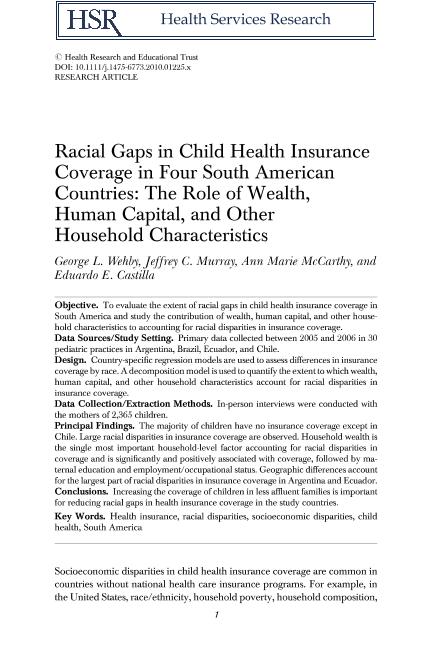Mostrar el registro sencillo del ítem
dc.contributor.author
Wehby, George

dc.contributor.author
Murray, Jeffrey C.
dc.contributor.author
McCarthy, Ann Marie
dc.contributor.author
Castilla, Eduardo Enrique

dc.date.available
2023-02-02T13:04:17Z
dc.date.issued
2011-12
dc.identifier.citation
Wehby, George; Murray, Jeffrey C.; McCarthy, Ann Marie; Castilla, Eduardo Enrique; Racial gaps in child health insurance coverage in four south American countries: The role of wealth, human capital, and other household characteristics; Wiley Blackwell Publishing, Inc; Health Services Research; 46; 6 PART 2; 12-2011; 2119-2138
dc.identifier.issn
0017-9124
dc.identifier.uri
http://hdl.handle.net/11336/186617
dc.description.abstract
Objective. To evaluate the extent of racial gaps in child health insurance coverage in South America and study the contribution of wealth, human capital, and other household characteristics to accounting for racial disparities in insurance coverage. Data Sources/Study Setting. Primary data collected between 2005 and 2006 in 30 pediatric practices in Argentina, Brazil, Ecuador, and Chile. Design. Country-specific regression models are used to assess differences in insurance coverage by race. A decomposition model is used to quantify the extent to which wealth, human capital, and other household characteristics account for racial disparities in insurance coverage. Data Collection/Extraction Methods. In-person interviews were conducted with the mothers of 2,365 children. Principal Findings. The majority of children have no insurance coverage except in Chile. Large racial disparities in insurance coverage are observed. Household wealth is the single most important household-level factor accounting for racial disparities in coverage and is significantly and positively associated with coverage, followed by maternal education and employment/occupational status. Geographic differences account for the largest part of racial disparities in insurance coverage in Argentina and Ecuador. Conclusions. Increasing the coverage of children in less affluent families is important for reducing racial gaps in health insurance coverage in the study countries.
dc.format
application/pdf
dc.language.iso
eng
dc.publisher
Wiley Blackwell Publishing, Inc

dc.rights
info:eu-repo/semantics/openAccess
dc.rights.uri
https://creativecommons.org/licenses/by-nc-sa/2.5/ar/
dc.subject
CHILD HEALTH
dc.subject
HEALTH INSURANCE
dc.subject
RACIAL DISPARITIES
dc.subject
SOCIOECONOMIC DISPARITIES
dc.subject
SOUTH AMERICA
dc.subject.classification
Epidemiología

dc.subject.classification
Ciencias de la Salud

dc.subject.classification
CIENCIAS MÉDICAS Y DE LA SALUD

dc.title
Racial gaps in child health insurance coverage in four south American countries: The role of wealth, human capital, and other household characteristics
dc.type
info:eu-repo/semantics/article
dc.type
info:ar-repo/semantics/artículo
dc.type
info:eu-repo/semantics/publishedVersion
dc.date.updated
2023-02-02T12:49:56Z
dc.journal.volume
46
dc.journal.number
6 PART 2
dc.journal.pagination
2119-2138
dc.journal.pais
Reino Unido

dc.journal.ciudad
Londres
dc.description.fil
Fil: Wehby, George. University of Iowa; Estados Unidos
dc.description.fil
Fil: Murray, Jeffrey C.. University of Iowa; Estados Unidos
dc.description.fil
Fil: McCarthy, Ann Marie. University of Iowa; Estados Unidos
dc.description.fil
Fil: Castilla, Eduardo Enrique. Centro de Educación Medica E Invest.clinicas; Argentina. Fundación Oswaldo Cruz; Brasil. Consejo Nacional de Investigaciones Científicas y Técnicas; Argentina
dc.journal.title
Health Services Research

dc.relation.alternativeid
info:eu-repo/semantics/altIdentifier/url/https://onlinelibrary.wiley.com/doi/10.1111/j.1475-6773.2010.01225.x
dc.relation.alternativeid
info:eu-repo/semantics/altIdentifier/doi/http://dx.doi.org/10.1111/j.1475-6773.2010.01225.x
Archivos asociados
